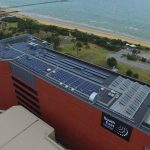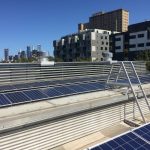The University of Melbourne is set to reduce their energy overheads and move a step closer to it’s sustainability goals with the installation of a 138kW solar PV system at their historic Southbank campus.
The campus is home to many of the performing arts programs of the University and was a challenging install for both the client and for our team.
The site is a high consumer of energy and features historic buildings with complex roofs and older electrical infrastructure. This required some creative thinking from the team for a system design that would provide enough energy to make a noticeable impact on the campus.
We developed a proposal for the University which not only delivered the energy results that they were looking for, but also addressed the numerous logistical and planning challenges that the site presented.
To begin with; the site features multiple roofs at different heights and different orientation. One of arrays is mounted on a nearly vertical (80 degree) section of the roof, while the rest are spaced out around the different roofs of the building. This required specialised safety equipment for the team as well as unique loading equipment to get the equipment to site safely. We also had to manage multiple other trades, who would be working onsite at the same time.
Shading was unavoidable at the site, especially in the early mornings. So the system was designed to take into the account the fluctuations that intermittent shading would create. Even with the shading issues, we were still able to deliver the desired energy output for the site.
The site also featured the unique insulation product Thermoshield. By combining light reflection with insulating properties, Thermoshield reduces the heat load on the roof and therefore, the rest of the building.
A cooler roof means less demand on services like air conditioning. It also means that the solar panels will be cooler which could increase their electrical output.
We’ve successfully worked with Thermoshield on previous projects and the University of Melbourne has conducted it’s own research into the effectiveness of the product. Their tests show that a solar PV system had its electrical output increased by 6% when installed on a roof which was coated with Thermoshield.
We managed the supply and successful application of the product on the site and coordinated the solar installation around the application of the product.
Aside from the site itself, we also had to respect the fact that students were still studying at the campus. We were limited in the hours that we could be onsite and had to mitigate noise levels at all times.
To manage the variety of different safety, logistical and timeline challenges of the project, we utilised our in house project management and engineering teams to develop a detailed engineering and OSH plan.
Doing as much preparation as possible before we picked up any tools was a key factor for our success on this project. The system was installed in autumn and was completed on time and on budget.









